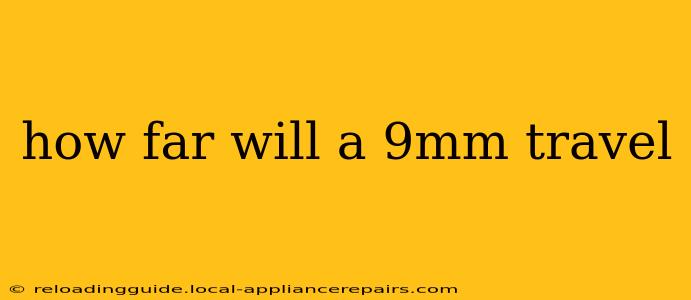The question "How far will a 9mm travel?" doesn't have a simple answer. The distance a 9mm bullet travels depends on several crucial factors, making it more complex than just stating a single number. This comprehensive guide will delve into the science behind 9mm bullet trajectory, exploring the key factors influencing its range and providing a clearer understanding of its capabilities.
Factors Affecting 9mm Bullet Range
Several interconnected factors significantly impact how far a 9mm round will travel:
1. Muzzle Velocity:
The initial speed at which the bullet leaves the gun's barrel (muzzle velocity) is paramount. Higher muzzle velocity translates to a longer range. Different 9mm cartridges and firearms will have varying muzzle velocities, impacting the overall distance. A higher-powered 9mm load will travel considerably farther than a lower-powered one.
2. Barrel Length:
Longer barrels generally produce higher muzzle velocities due to increased propellant burn time. This directly increases the distance the bullet can travel. Conversely, shorter barrels result in lower muzzle velocities and reduced range.
3. Ballistics Coefficient (BC):
The BC represents the bullet's ability to overcome air resistance. A higher BC indicates better aerodynamic efficiency, allowing the bullet to retain its velocity over longer distances. Different 9mm bullets have varying BCs depending on their shape, weight, and construction. A heavier, more aerodynamic bullet will travel further than a lighter, less aerodynamic one.
4. Environmental Conditions:
Wind speed and direction significantly affect trajectory. Strong headwinds will reduce range, while tailwinds will extend it. Air density, influenced by temperature, altitude, and humidity, also plays a role. Denser air increases air resistance, shortening the range.
5. Angle of Fire:
The angle at which the gun is fired impacts the bullet's trajectory and range. A steeper angle will result in a shorter horizontal distance compared to a flatter trajectory.
Effective Range vs. Maximum Range
It's crucial to distinguish between effective range and maximum range.
Effective Range:
This refers to the distance at which a 9mm round can reliably achieve its intended purpose, typically incapacitating a target. The effective range for a 9mm is generally considered to be within 50-75 yards (45-68 meters), although skilled shooters might extend this slightly under ideal conditions. Beyond this distance, accuracy and stopping power decrease significantly.
Maximum Range:
This signifies the furthest distance a 9mm bullet can physically travel. The maximum range can vary greatly depending on the factors discussed above, but it can exceed 1 mile (1.6 kilometers) under ideal conditions. However, at this distance, the bullet's velocity and accuracy are drastically reduced, rendering it far less effective.
Conclusion: Understanding the Nuances
While a 9mm bullet can travel over a mile in optimal conditions, its effective range is considerably shorter. The actual distance a 9mm round will travel depends significantly on various factors. Responsible firearm handling and understanding these ballistic principles are crucial for safe and effective firearm use. Remember to always consult with qualified firearms instructors and adhere to all relevant safety regulations.

